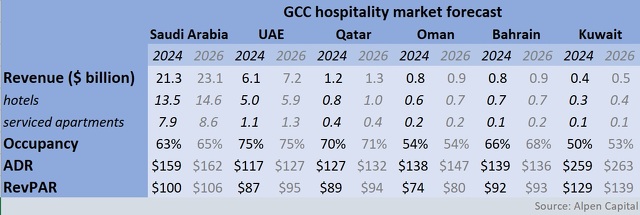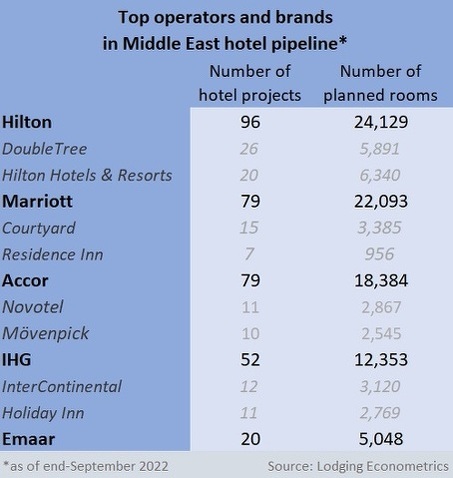The tourism market the Middle East is expected to grow at a healthy CAGR of 5% in the next decade to over $400 billion in 2032 from $246 billion in 2022. Hospitality revenues in member countries of the Gulf Cooperation Council (GCC) – the UAE, Saudi Arabia, Qatar, Oman, Bahrain and Kuwait – are foreseen to expand even faster, at a CAGR of 6.6%, to a combined $34 billion in 2026.
The Middle East outperformed all other markets in terms of recovery in the tourism sector last year, with its international arrivals rebounding to 83% of 2019 levels. The total number of arrivals in the region more than doubled to 60.3 million in 2022 from 24.7 million in 2021. GCC countries accounted for 44.1 million of this total last year, just below the 47.7 million they recorded in 2019.
Growth was driven in part by major events in 2022, like Expo 2020 in Dubai that recorded 24.1 million visits and the FIFA World Cup in Qatar that attracted 1.4 million visitors. The number of participants at the Hajj pilgrimage in Saudi Arabia rose to 900,000 last year from 60,000 a year earlier after Covid-19 restrictions were relaxed. They will be lifted in 2023, which may further boost attendance.
The Middle East is one of only two regions, with the other being Europe, where arrivals are set to return to pre-Covid levels this year, the UNWTO said. Air ticketing data from late 2022 suggest that the Middle East will likely to show growth in international arrivals going into 2023, with travel to the region up by 15% on pre-pandemic levels in the first quarter.
Tourism development programs
Future tourism development in the region is expected to be supported by ambitious government-led programs and new policies to diversify away from oil and gas in several countries:
– Saudi Arabia is seeking to attract 100 million tourists a year by 2030 as part of its wider Vision 2030 economic program. Its sovereign wealth fund PIF is funding megaprojects to develop destinations, while the government further eases visa procedures, after issuing the first tourist visas in 2019.
– The UAE announced plans in 2022 to attract $27 billion in tourism investments, have 40 million hotel guests and increase tourism contribution to $112.5 billion of GDP by 2031.
– Qatar is targeting to have 6 million visitors annually by 2030, up from about 2.5 million in 2022. It will also pour $3.7 billion of investment into developing 35 sport, entertainment and cultural venues across the country by 2030 through the new Events Investment Fund, launched in January 2023.
Hotel markets and performances
The Middle East had 1.13 million rooms available for accommodation in total in 2019, up from just 628,000 in 2010. Saudi Arabia and the UAE, the two leading markets in the region, increased their number of rooms by a robust 169% and 147% in this period to 567,000 and 183,000, respectively. GCC countries were estimated to have around 425,000 hotel rooms combined at the end of September 2022, with around 202,000 operated in the UAE and 136,000 in Saudi Arabia.
The Saudi, UAE and Qatari markets are dominated by international hotel brands and operators, such as Accor, Marriott, Hilton and IHG, with local firms, like Abu Dhabi-headquartered Rotana, Dubai-based Jumeirah, UAE developer Emaar and Qatari group Katara, also playing a role.
Occupancy in the Middle East averaged 63.6% in 2022, still lagging behind pre-pandemic levels by 3.3 percentage points. But local properties beat their peers in Europe, North America and Asia in building back occupancy. Middle East hotels recorded average ADR and RevPAR of $173.10 and $110.12 last year, respectively, above 2019 levels and also higher than in any other region.

Hotels in Dubai recorded the highest GOPPAR across the Middle East last year at $132.68, reaching 140% of pre-pandemic levels. Oman showed the lowest recovery at 78% of the pre-Covid comparable. Helped by the FIFA World Cup, Qatar had the second-strongest recovery in the world last year (behind Miami), with its GOPPAR reaching 152% of 2019 levels, or $68.07, in 2022.
Qatar also achieved a leading position in another global ranking last year: its capital, Doha, topped the list of cities with the highest share of five-star properties among local hotels, at 51.43%. Abu Dhabi in the UAE came in third, with a five-star share of 28.43% in its overall inventory.
Hotel performances are expected to further improve in the coming years. Saudi Arabia will remain the largest market among GCC countries by far, but its share of combined revenues is forecast to edge down to 68.1% in 2026 from 69.6% in 2024. Occupancy will be the highest in the UAE in 2024-26, albeit stagnating. ADR and RevPAR are projected to be the highest in Kuwait in this period.

The hotel sector could be one of the biggest beneficiaries of the recently launched development programs in the region, which not only aim to build super tourism infrastructure and create first-class destinations and attractions but also to expand and diversify the accommodation supply.
Megaprojects and super-cities
Development projects in the Middle East are expected to be dominated by Saudi Arabia’s Vision 2030 program, which would add stand-alone super-cities and several other real estate and infrastructure megaprojects with a value of a staggering $1.1 trillion. The program involves the construction of over 550,000 residential units and more than 275,000 hotel rooms. Key projects include:
– Neom, a $500 billion super-city with industrial, commercial, residential and tourism facilities. It will include the Shindala island destination, scheduled to open in 2024, the Trojena mountain destination, to be completed by 2026, and the futuristic Line and Oxagon sub-cities.
– Amalaa, a 4,155 km2 ultra-luxury and wellness destination along the Red Sea coast, set to open in 2024. It is envisioned to offer around 3,000 rooms in 25 hotels, as well as private residential villas, apartments and estate homes, fine dining and recreational facilities.
– The Red Sea, a destination along the northwestern coast, is scheduled to open in 2023. It would offer 8,000 rooms in 50 hotels, up to 1,000 residential properties and have an international airport by 2030. Visitor numbers are foreseen to reach 1 million per year at full capacity.
– Soudah Development, a luxury mountain destination in the Asir region that is expected to attract 2 million visitors annually by 2030. It would offer 2,700 hotel rooms, 1,300 residential units and 30 experiential attractions, with creating over 8,000 new jobs by 2030.
– Diriyah Gate, the cultural heritage giga project in Riyadh
– Qiddiya, the entertainment giga project in Riyadh
Several developments are backed by Saudi sovereign wealth fund PIF, although the country is also seeking to attract private investors. Saudi Arabia and the UAE are expected to receive the biggest part of future hotel investments in the GCC region, with the two countries showing $64.5 billion and $23.2 billion in tender or bid evaluation across all real estate sectors in 2023.
The UAE is also planning several large hospitality developments, including the Al Marjan Island project in the emirate of Ras Al Khaimah, which, among others, would include the 1,000-room Wynn Ras al Khaimah hotel complex. Scheduled to open in 2026, the $2.5 billion property will be the first casino hotel in the Gulf Arab region, where gambling has been off limits so far.
Another key project in the UAE is the 302-meter Wasl Tower skyscraper on the famous Sheikh Zayed Road in Dubai, which is expected to be completed in the second quarter of 2024. The 63-story mixed-use building will contain a Mandarin Oriental hotel with 258 rooms and serviced apartments on floors 16 to 38. The brand will also manage 114 residences on upper floors.
Hotel pipeline and new openings
Middle East & Africa was the only region in the world to show an increase in hotel pipeline activity at the end of the fourth quarter in 2022. There were 238,635 rooms under contract in total in this region, up by 1.1% from a year earlier. Out of this total, 122,686 rooms were under construction, including 40,742 rooms being built in Saudi Arabia and 27,456 in the UAE.

Earlier research has suggested that GCC countries had more than 170,000 hotel rooms combined in their active development pipelines (planning, final planning and under construction) as of the end of September 2022. The wider Middle East region was forecast to record 115 new openings with 28,776 rooms in 2023 and 124 openings with 30,169 rooms in 2024.
Saudi Arabia’s provincial region had the biggest construction pipeline with 76 projects and 15,298 rooms at end-September 2022, followed by Riyadh with 61 projects and 12,430 rooms and Doha with 55 projects and 12,789 rooms. The top five hottest markets also included Jeddah with 42 developments and 8,956 rooms, and Makkah with 31 projects and 21,228 rooms.




